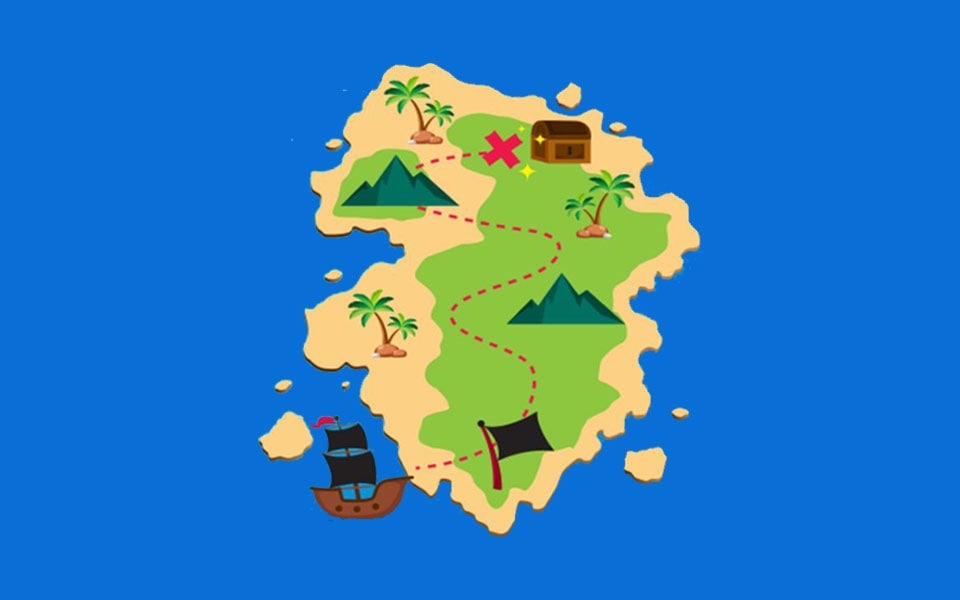Subscribe to Our Newsletter
Stay updated with the latest tips and strategies. Get additional discounts and alerts on offers.

The great writer Robert Louis Stevenson authored an adventure novel called Treasure Island which has been rewritten, adapted to a movie & still adored by kids around the world. The novel tells the tales of Jim Hawkins & Long John Silver who outsmart each other in order to find the buried treasure.
It’s greatly influenced by popular perceptions of pirates, tropical islands, one-legged seamen bearing parrots on their shoulders & treasure maps marked with “X”. There are instances in the story where the crew fights over each other for the treasure map. But besides all the fiction, maps have been really important in a range of activities for people. And now the concept has been adopted by agile marketing in the form of content mapping.
You won’t be alone if you haven’t heard of the term ‘content mapping’. While it’s the dark nature of marketers to throw around terms, often, just to confuse people.
Yet understanding how to map your content is a vital aspect of a profitable marketing strategy. In simple terms, content mapping is a content-centric marketing approach that is solely based on the intent of the user. Imagine that someone is talking to you & you drift away thinking,
“Why am I still listening?”
No marketer would want their website to be like that silly talker because in the world of the internet, staying & listening is not necessary. Your visitors will leave while your site is still talking to them. The good thing about content mapping is it helps you talk to your visitors & not at them. To avoid confusions,
content mapping process should include:
It always has been important for marketers to match content to its intent but it’s more than necessary in today’s age. It’ll be damn premature if you expect a visitor who visits your website to know about your company & offerings to make a purchase.
They will most likely get annoyed & will lose trust in your company. And on the other hand, if the visitor wants to buy but cannot because of the endless list of benefits & testimonials, the money will be transferred to a competitor who has a ready to “buy now” button.
No matter the size of the business, marketers face limited budget, time & resources to grow customer base. The purpose of content mapping is to ensure the efficiency & effectiveness of marketing efforts according to the position of the customer.
Content mapping offers insights which include:
With content mapping, you will be able to build relationships & interactions between different pieces of content. Every piece of the content needs to support customer journey & visually mapping the content is one of the best methods to clarify the workflow that your customers will experience. It also enables you to think ahead about the possible extras that could result in additional content without spending too much time.
The needs & expectations of your customers change as they progress through the buyer’s journey. The content generated must be addressed specified at each stage to ensure your business can close more sales. It’s not just enough to produce great looking content and there is no way you can spam your way to success anymore. Mobile devices have claimed the website traffic majority, so marketers not only have to map based on content types but also have to strategize according to how customers will consume content.
This gets more troublesome when you have to coordinate user personas, marketing content & where your target audience is at in the customer journey. The best way to manage this is to always remember the needs of the customer. Your content map should include how several channels & content types interact and highlight interactions of specific content types in marketing campaigns. A solid content mapping strategy depends on the marketer’s ability to integrate the triggers within specific channels & how interactions fall out throughout the overall customer journey. This will bestow your team with an overview that’s needed to understand how everything works.
This pool of information will direct your marketing initiatives by laying out key components which include:
Marketers should make sure that no matter the scope of content mapping, time & cause/effect relationships to understand who, what & when content will be triggered.
Customer journey funnel is the process that every buyer goes through as they start identifying problems & then investigates options that are available to solve it. As customer becomes confident in the options, the final decision will be made. Content mapping as per customer journey doesn’t mean putting out information that marketers find interesting.
Materials that audience wants to see should be developed. Marketers can start out by mapping the journey associated with each persona, which outline what they will be looking for during each stage. Try to identify keywords that will be likely used & the types of content that they will likely be seeing.
For example:-
Awareness stage: This is the stage where the fresh prospects identify that they have a problem & are just starting to research the possible solutions. Here they won’t be sure about what they are looking for, will be asking board questions & will be open to suggestions. Here they will respond best to:
Consideration & Evaluation stage:
Here the prospects have begun to become familiar with the brands that promise to solve their issues. They become more direct in their searches & start comparing products & brands. Here they will respond best to:
Purchase stage:
Here the prospects will start making decisions about the brand & the product that will best fit their needs & then make purchase. Here they will respond best to:
Post purchase stage:
Once the purchase is made, it doesn’t mean that the business is over. Marketers should continue to offer outstanding content to help them get most out the decision. Here they will best respond to:
Take your topics & keywords, outline your buyer’s journey, type your content & piece everything together. Try to find the gaps in the path & create the content needed to fill them. Create all future content with a purpose to fill a role along the buyer’s journey. All this will lead to great content mapping.
Ready to practice content mapping?
Map your content as per the marketing leads provided by DataCaptive

Content mapping cannot be done fast as it needs time. This is because the aim is not to create content for the sake of creating content. If your content is not relevant or interesting, every minute spent on them will be a waste of time. Also while there are plenty of tools out there to help marketers in content mapping, marketers should always choose the option that keeps the focus on customers & not on the tool that’s used.
Content mapping is about making your content about the customer, not about you, your company & what tools you use. You continue shouting about your company on all available media or you can start listening & make content for your customers.
Also read on: ACCURACY OF ACCOUNT BASED MARKETING
Show Some Love!

Subscribe to Our Newsletter
Stay updated with the latest tips and strategies. Get additional discounts and alerts on offers.
Related Articles
Subscribe to Newsletter
Stay up to date with the latest marketing, sales, and service tips and news.
Limited Time! Celebrate the spirit of freedom with 30% OFF on all B2B databases.
Unlock high-quality leads and drive your campaigns further with accurate, verified data trusted by thousands of businesses.
Don’t miss out—power up your marketing while the offer lasts!
